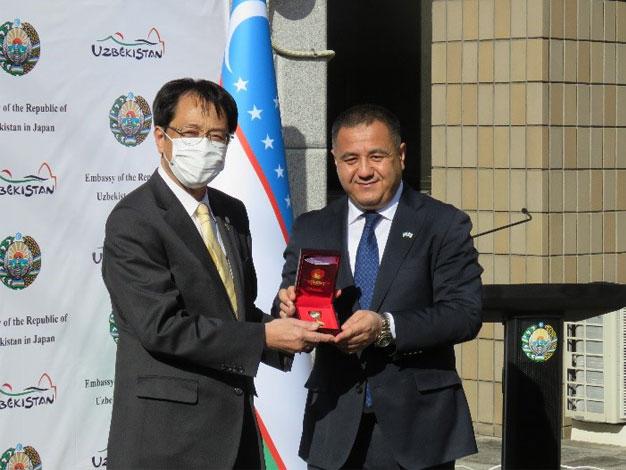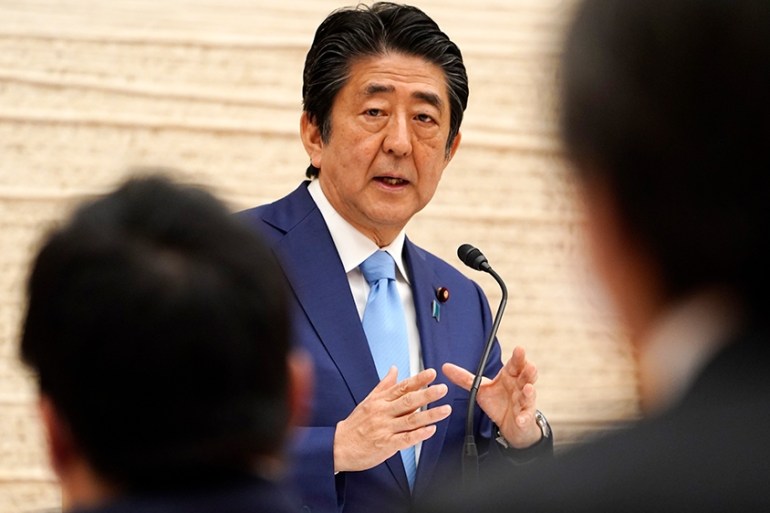[ad_1]
Late-night conference calls were the norm for Andy Lin when he was an engineer in California for a global semiconductor company. The time difference with clients in Taiwan, where the firm is headquartered, meant he’d often find himself feeling famished after most diners closed.
One night he finished work at around 3 a.m. and decided to see if there were any vending machines that sold what he was craving — satiating soup and noodles. He came up empty. Instead, he discovered on YouTube that there were vending machines serving hot bowls of udon (wheat noodles) in Japan 30 to 40 years ago.
“I did some further research and found it was still popular because it’s a (retro) machine that’s still working and everyone wanted to try it,” he says. “But the overall design was outdated, so I thought we could use the latest technology to make the machines modern and better.”
Thus was born the concept behind Yo-kai Express, an autonomous restaurant platform Lin founded in 2016 that offers contactless, freshly prepared meals with an expanding palate of menus — 24 hours a day.
Already deployed in 50 locations across the United States — hotels, schools, hospitals, corporate dining areas and ski resorts, to name a few — the Silicon Valley startup recently entered the market in Japan, the land that offered Lin his original source of inspiration and the purported vending machine capital of the world.

While the number of vending machines in Japan has been shrinking in recent years, the nation still boasts the highest number of units per capita of any country. And the COVID-19 pandemic has underscored the advantages of these unmanned vendors, leading to a flurry of new — and sometimes bizarre — products being offered inside the electronic boxes.
In early April, Yo-kai sent its ramen dispensers to Haneda Airport, Tokyo Station and a parking area in the capital’s central Minato Ward. Four types of steaming bowls of noodles are currently available, priced at ¥790 and served in 90 seconds. By the end of the year, the firm hopes to introduce 250 of them throughout the nation, with hundreds more envisioned in the years ahead.
“People have been trying to eliminate human contact, and that’s why more food and beverage operators are trying to use our system to replace on-site human labor,” Lin says. “I think it’s a good solution for everybody at this point.”
Vending haven
Vending machines are ubiquitous in Japan. They can be found on almost every urban street corner, as well as inside corporate offices, commercial buildings and train stations — not to mention highway rest stops and even along rural roads.
While their numbers have been steadily falling, there were still 4 million in the nation as of the end of December, according to the Japan Vending System Manufacturers Association — roughly 1 for every 31 people. These also include money changers, ticket machines and coin lockers, among other similar devices.

That figure is expected to inch down to 3.96 million this year, according to the Yano Research Institute, as those installed in unprofitable locations are being removed due to pressure on operators’ profits in an aging, shrinking nation.
And while more than half of all vending machines sell beverages, advances in technology and demand for contactless purchases have seen the devices accommodate an expanding range of products.
There are vending machines that sell crepes, gyōza dumplings, roasted sweet potatoes, pizza, curry and, for the curious foodie, edible insects. It’s not just meals. Some offer face masks, toys, SIM cards, dolls, clothes, drones and even engagement rings — you name it.
The dispensers are also good PR. In March, Tanaka Jitsugyo Co. began selling locally sourced frozen wagyu beef steaks and other meat products in a vending machine by a gasoline stand it operates in the city of Tsuyama, Okayama Prefecture. Since then, it has been receiving a steady stream of media inquiries.
“Thanks to the coverage, sales have been robust,” says Ryohei Marumo, an employee at the firm who is responsible for setting up the vending machine. “The pandemic and the need for contact-free purchases gave us the idea. Now we’re planning to introduce more products.”

In Nagasaki, meanwhile, the southern prefecture’s fishery cooperative began offering frozen sashimi and other fish-based dishes in a vending machine erected by the entrance of its office.
“The health crisis has seen the amount of seafood consumed at restaurants slump, so we were looking for an original, fun way to advertise the local catch,” says Takuro Yoneda, an official at the cooperative.
“The feedback has been surprisingly positive,” he says, so much so that the vending machine needs to be refilled with products twice a day.
Beverage makers, who have been driving the domestic market, have also been experimenting. DyDo DRINKO Inc., which operates around 270,000 vending machines nationwide, started selling paper diapers and wet wipes alongside its drinks for parents in a pinch.
“We’ve set up around 250 of them so far, mostly at roadside rest areas and inside shopping complexes,” says Makoto Masamoto, a spokesperson for the company. “It’s not so much about generating profit, but more for the convenience of consumers.”
Pervasive presence
The oldest surviving vending machine in Japan was created in 1904 by inventor Takashichi Tawaraya to sell postage stamps. The device, which looks like an antique wooden chest, is exhibited at the Postal Museum Japan in Tokyo.

Things really started to take off, however, when Coca-Cola Co. introduced vending machines selling the beverage giant’s signature bottled drinks in 1962.
The proliferation of these dispensers picked up speed when the ¥100 coin, first minted in silver, was recast with more affordable cupronickel in 1967. That saw the number of coins in circulation soar and allowed the Japanese public to casually purchase drinks with pocket change.
And during the 1970 World Expo in Osaka, Fuji Electric Co., Japan’s largest maker of vending machines, showcased new models selling both hot and cold drinks to the event’s approximately 60 million visitors. Innovation hasn’t stopped since, says Saburo Tokita, a manager at the firm’s food distribution business headquarters.
“We’ve developed machines equipped with a swing hatch that can be installed in smaller spaces, for example, and barrier-free models and disaster-responsive vending machines with internal batteries that can run on their own when the power is out,” Tokita says.
The latter were useful when a magnitude 9 earthquake and tsunami devastated northeastern Japan in 2011. The subsequent power shortages also led Fuji Electric and its rivals to create dispensers with energy saving features.
“From a societal perspective, a big factor behind the spread of vending machines in Japan is its low crime rate,” says Yasuhiro Yamazaki, managing director of the Distribution Economics Institute of Japan.

While many vending machines now accept electronic payments, Japan remains a primarily cash-reliant society, meaning these conspicuous boxes could be easy targets of vandalism. Despite typically containing tens of thousands of yen, however, they are seldom broken into.
The number of vending machines nationwide kept growing until 2000, when it peaked at around 5.6 million, generating annual sales of ¥7 trillion. The market has been gradually contracting ever since, with revenue down to ¥4.7 trillion in 2016, according to the latest figures available from JVMA. The drop is partly due to the rapid decline in dispensers selling alcohol and tobacco, Yamazaki says.
“Still, the big draw of vending machines is how they can save on labor costs when Japan is suffering a chronic shortage of workers,” Yamazaki says.
Convenience stores, another pervasive presence in the nation — and a line of business that has been facing a severe drainage of manpower — have already been betting on that prospect. Over the past decade, operators have been setting up dispensers in island-like groups to serve as a fully automated and unmanned 24-hour convenience store.
FamilyMart Co., which operates around 16,600 convenience stores in Japan, calls the concept “Automatic Super Delice” and has installed around 2,300 vending machines so far for such purposes in offices, hospitals, logistical facilities and schools.
Typically consisting of several vending machines sitting side by side under the FamilyMart logo, they offer a comprehensive range of products, including the standard hot and cold drinks as well as food such as rice balls, sandwiches, salads, pasta and yogurt.

“We’re seeing demand from workers who are refraining from dining out during the pandemic, as well as those on night shifts who lack meal options,” says Satoru Yoshizawa, a spokesperson for the company.
The sheer breadth of the products these machines can accommodate, as well as the retro allure of some of the older models, have also attracted a dedicated fan base.
Retro dispensers
Makoto Nomura was a 17-year-old high school student when he first fell in love with vending machines.
This was during the early 1990s, when there were still stands selling old-fashioned boxed “Guten burger”-brand hamburgers — his favorite, despite its rather bland taste. It wasn’t just burgers. One day while commuting to school, Nomura came across a drive-in that sold hot udon, toast and miso soup from vintage machines that were already becoming a rarity back then.
“That really triggered my curiosity,” says the 48-year-old system engineer and self-confessed introvert. He continued researching during his spare time, his obsession fueled whenever he discovered machines of interesting design, concept or product.
In 1998, he started a blog chronicling his finds, and soon became the go-to person when it came to discussing Japan’s vending machine culture. And while technology has seen the quality of the autonomous stalls improve significantly, he says there’s still a strong following behind retro machines.

A popular pilgrimage site for connoisseurs is a used tire shop in the suburbs of Sagamihara, Kanagawa Prefecture. Next to a parking lot are nearly 100 old vending machines sitting side-by-side, hawking anything from ramen and shaved ice to o-mikuji paper fortune slips.
Since makers no longer produce nor repair these boxy relics, the owner of the shop routinely conducts maintenance checks on his own while replenishing stock for customers, who can number in the hundreds during weekends and holidays.
Even on a recent rainy, weekday morning, there were around a dozen people trying them out, giving the place a carnivalesque feel, only without physical vendors.
A middle-aged woman and her husband were sharing a plate of curry rice, while a couple with their newborn were discussing whether to buy a hamburger or a hot sandwich. There were also dispensers selling udon — those that inspired Yo-kai Express.
After inserting ¥300, a hot bowl of noodles with dashi broth and topped with seasoned fried tofu was served in a little under 30 seconds. It was surprisingly flavorful for its price.

“These machines were popular during the 1980s, before fast food restaurants and convenience stores began taking over,” Nomura says. “Back then, there weren’t many dining options late at night, so they catered to that demand.”
Modern technology has seen these stalls undergo significant makeovers. There are AI-enabled salad vending machines and cloud-based models to improve operational efficiency. Advancement in robotics has seen firms such as Yo-kai Express produce devices that can serve a variety of hot meals assembled on the spot.
And while Japan’s market has been contracting, Nomura believes there’s still much potential to be unearthed. In fact, globally, the market has been expanding, with the IMARC Group expecting its value to grow from $18.5 billion in 2021 to $25.3 billion by 2027.
“I’m sure they will survive, and perhaps even see a resurgence to compensate for the shrinking labor pool,” he says.
Nomura’s goal is to eventually open an unmanned store filled with rare vending machines, akin to a museum.
“I was never very good at communicating with people, and that was why I was drawn to the device in the first place,” he says. “It’s strange when you think of it, because now I get to meet so many new people through our common passion — vending machines.”

In a time of both misinformation and too much information, quality journalism is more crucial than ever.
By subscribing, you can help us get the story right.
SUBSCRIBE NOW
KEYWORDS
vending machines, Longform
[ad_2]
Source link




















